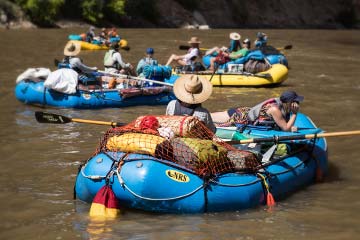How to Make a Flip Line
Due to your cookie choices, we cannot show you this content. Adjust your settings?
A flip line, or guide belt, made with a length of webbing and a locking carabiner, has many different uses for kayakers, rafters and canoeists. In addition to helping flip an overturned raft, you can use it to make a rescue anchor, boat tether, rescue harness, etc. Swiftwater rescue instructor Jim Coffey shows how to build yours.
To make the flip line, or guide belt, take a long piece of tubular webbing and fold it in half. Place the fold, or bight, at your midsection and loop the free ends twice around your waist. Where they join up with the bight, tie the two free ends together with a water knot (also known as a ring bend).
To make a water knot, tie an overhand knot in one end of the webbing leaving the desired length of the loop free. Retrace the knot in the opposite direction with the other end of the webbing and pull tight. Make sure the free ends are about three inches long so you can visually inspect the knot for slippage during use.
You want the webbing loop to be long enough to stretch around bulky winter paddling gear (and maybe a few extra pounds). When you’re dressed more lightly you can just twist the webbing to shorten the belt before clipping in the locking carabiner. You definitely want to use a locking biner, to prevent an accidental entrapment hazard.
The flip line, or guide belt, can be used for a variety of purposes. Hook it onto a D-ring of an overturned boat for aid in flipping it back upright. It can serve as an anchor for a z-drag boat extraction. You can form it into body harness and use it to tie your boat to shore. It can be used for anything from helping to sink a line down to get underneath a trapped person to making a clothesline for drying gear.
 NRS Gift Card: Always Fits, Always Wanted
NRS Gift Card: Always Fits, Always Wanted




